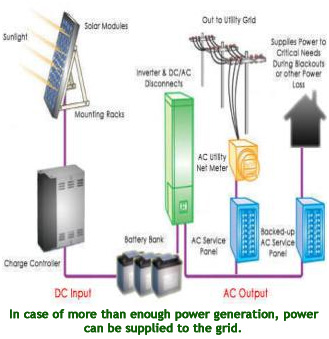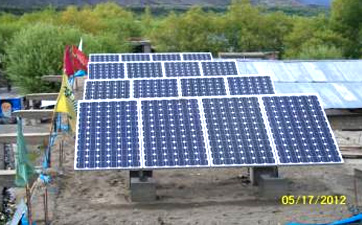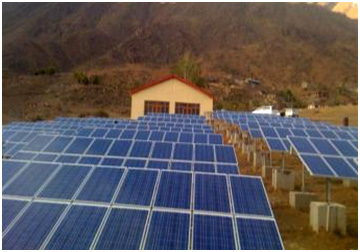|
 |
 Photovoltaic systems convert sunlight into electricity. A small solar photovoltaic system can be a reliable and pollution free producer of electricity. Presently there are around 157 villages in Kargil,
out of which only 97 villages are electrified (95% through DG Sets). There are mainly two power stations one small hydro (Iqbal Project) with an installed capacity of 3.75MW and one
DG station with 4MW capacity that
supplies electricity to the main town of Kargil and villages nearby.
There are also two numbers of mini hydroelectric power units and some DG sets (with capacity ranging from 50-750 KVa) mostly installed in the progressive villages. Photovoltaic systems convert sunlight into electricity. A small solar photovoltaic system can be a reliable and pollution free producer of electricity. Presently there are around 157 villages in Kargil,
out of which only 97 villages are electrified (95% through DG Sets). There are mainly two power stations one small hydro (Iqbal Project) with an installed capacity of 3.75MW and one
DG station with 4MW capacity that
supplies electricity to the main town of Kargil and villages nearby.
There are also two numbers of mini hydroelectric power units and some DG sets (with capacity ranging from 50-750 KVa) mostly installed in the progressive villages.
Because of the scattered nature of the villages there is a huge problem with distribution and transmission through power grid systems. The transmission lines are very long resulting in poor voltage regulation
and high distribution losses and also it requires huge capital investment which is financially not feasible. Therefore KREDA is concentrating on decentralized power generation policy, which would be the best
alternative for such rural and far-flung areas/villages of Kargil.
EXECUTION OF SPV POWER PLANTS
Works Done During the Period from June 2010 to December 2010
 During the period KREDA has established 10 SPV Power Plants in various villages of the district.
In these villages, apart from solar energy, no other viable resource, renewable or otherwise, is available.
Before the intervention of KREDA the villagers were receiving electricity from their respective DG sets.
The 10 SPV Power Plants of 40KWp capacity are installed in the villages of Tsazar, Saliskot, ShakarAmzet,
Khangral, Lhalung, Barchey, Yurbaltak, Goshan, Pandrassand Gindyal. Among them Tsazar (Zanskar) was an unelectrified village. During the period KREDA has established 10 SPV Power Plants in various villages of the district.
In these villages, apart from solar energy, no other viable resource, renewable or otherwise, is available.
Before the intervention of KREDA the villagers were receiving electricity from their respective DG sets.
The 10 SPV Power Plants of 40KWp capacity are installed in the villages of Tsazar, Saliskot, ShakarAmzet,
Khangral, Lhalung, Barchey, Yurbaltak, Goshan, Pandrassand Gindyal. Among them Tsazar (Zanskar) was an unelectrified village.
The two main objectives of the agency in installing these power plants are firstly to minimize the diesel consumption in same villages and secondly to
supply these villages with an uninterrupted power supply.
The average number of households in each village covered under the SPV Power Plant is around 100 (i.e. 100x10=1000 households in total approx.). Although the SPV power plants have not yet replaced the DG sets completely,
they have at least freed the villages from the problem of frequent breakdown of electricity, especially during the harsh winter months.
The project was successfully conceived and implemented by KREDA with technical support from TATA BP Solar India Ltd. The executing agency completed the installation of the plant equipment in the month of October-November 2010. Meetings were held with beneficiaries at the time of project design documentation; it was headed by the councilors and Sarpanchs. The villagers are also the active participants in the project activities, be its operation, maintenance or MOU related any other formality.
The power plant, after handed over by KREDA to the villagers, will be run and maintained by the Electricity Management Committee (EMC).
Works Done During the Period from April 2011 to Ending October 2012 :
 The northern part of the subcontinent, especially the Ladakh region, is blessed with an abundance of sunlight and high solar radiation. Harnessing solar energy into consumable electricity is highly effective and useful.
Under Ladakh Renewable Energy Initiative, a scheme sanctioned by MNRE GOI to minimize dependence on diesel in the
Ladakh region and meet power requirement through local renewable sources, KREDA has established number of SPV Power
Plants capacity ranging from 25 kWp to 100 kWp in various villages and Army establishments, small Photo Voltaic Power Plants in various institutions capacity ranging from 2.5 kWp to 10 kWp. Works have been done in Twenty two villages, most of which are remotely located, and two Army establishments and nearly 62 institutions which had already been listed to be electrified are also completed.
It is expected that all SPV Power Plants will be completed by July this year (2013).
The northern part of the subcontinent, especially the Ladakh region, is blessed with an abundance of sunlight and high solar radiation. Harnessing solar energy into consumable electricity is highly effective and useful.
Under Ladakh Renewable Energy Initiative, a scheme sanctioned by MNRE GOI to minimize dependence on diesel in the
Ladakh region and meet power requirement through local renewable sources, KREDA has established number of SPV Power
Plants capacity ranging from 25 kWp to 100 kWp in various villages and Army establishments, small Photo Voltaic Power Plants in various institutions capacity ranging from 2.5 kWp to 10 kWp. Works have been done in Twenty two villages, most of which are remotely located, and two Army establishments and nearly 62 institutions which had already been listed to be electrified are also completed.
It is expected that all SPV Power Plants will be completed by July this year (2013).
Renewable energy has begun making visible impact in the District energy scenario. The solar power plants have benefited thousands of rural folk by meeting their lighting and other energy requirements in an environmentally benign manner.
Some Likely Result :
 Renewable energy is certainly a carbon free, inexhaustible and abundant source of energy. It is derived from sources such as Sun, Wind, and Water etc. It should be noted that a variety of situations will be encountered while planning the
layout of renewable energy plants (physical, social, administrative, economic etc.). But once such a plant is installed it can effectively contribute to combating climate change while at the same time providing various environmental, social and economic benefits. Renewable energy is certainly a carbon free, inexhaustible and abundant source of energy. It is derived from sources such as Sun, Wind, and Water etc. It should be noted that a variety of situations will be encountered while planning the
layout of renewable energy plants (physical, social, administrative, economic etc.). But once such a plant is installed it can effectively contribute to combating climate change while at the same time providing various environmental, social and economic benefits.
 |
|
Yet another 22 villages in the district, comprising of nearly 2500 households, will be electrified under the Ladakh Renewable Energy Initiative Scheme implementing by KREDA. |
|
|
|
 |
|
It will make the Power Development Department enable of saving thousands of liters of diesel,
resulting in saving of crores of rupees annually and it will bring down the load in already running DG Sets |
|
|
|
 |
|
The plant will have no adverse environmental impact.
It will rather improve the status of environment by eliminating the harmful gases,
which the diesel stations emits into the atmosphere (per 50,000 liters of diesel emits up to 128 ton of carbon dioxide). |
|
|
|
 |
|
The solar power plants will enhance the quality of life and improve living conditions of the people |
|
|
|
|
HOME LIGHTING SYSTEM :
 In Kargil the remote un-electrified and inaccessible villages such as Sapi, Batambis, Barsoo Nallah,
Kukshow, Pacharik, Umba, Lankercheybrok and many more in Zanskar comes under the category of remotely
located and marginalized areas. The Government sponsored development programmes on electrification are
mainly focused in some areas. Rural communities still rely on traditional energy resources like biomass
which leads to deterioration of the environment. Moreover the villages and hamlets are highly scattered and isolated.
Therefore, as a response to these challenges, LAHDC Kargil through KREDA had decided to distribute Home Lighting Systems in these villages.
In Kargil the remote un-electrified and inaccessible villages such as Sapi, Batambis, Barsoo Nallah,
Kukshow, Pacharik, Umba, Lankercheybrok and many more in Zanskar comes under the category of remotely
located and marginalized areas. The Government sponsored development programmes on electrification are
mainly focused in some areas. Rural communities still rely on traditional energy resources like biomass
which leads to deterioration of the environment. Moreover the villages and hamlets are highly scattered and isolated.
Therefore, as a response to these challenges, LAHDC Kargil through KREDA had decided to distribute Home Lighting Systems in these villages.
The System:
Solar Home Lighting System is powered by solar energy using solar cells that convert solar power energy (sunlight) directly to electricity . The electricity is stored in batteries and used for the purpose of lighting whenever required. These systems are useful in un-electrified and partially electrified rural areas and as reliable emergency lighting system for important domestic applications.
System Cost:
The Home Lighting System has been distributed among the communities of non-electrified villages/partially electrified villages identified and approved by LAHDC Kargil free of cost.
Beneficiary:
Every individual belonging to an area/village, falling in Kargil district, with no access to any source of electricity or partially electrified, identified and approved by LAHDC Kargil , is to be considered as a beneficiary. About 2000 Nos of HLSs has been distributed among villagers. The Scheme has been completed in November 2011.
Advantages:

 Availability of light for about four hours every day.
Availability of light for about four hours every day.
 There is no cost of lighting.
There is no cost of lighting.
 It eliminates burning of fossil fuel products like candles and kerosene lamps, thus protecting the environment.
It eliminates burning of fossil fuel products like candles and kerosene lamps, thus protecting the environment.
 It is useful for studying, cooking and other household activities.
It is useful for studying, cooking and other household activities.
| S.No. |
System |
No. of villages |
No. of Inst. Given HLS |
No. of HLS distributed |
| 1 |
HLS |
26 |
26 |
2000 |
 DETAILS:
DETAILS:
 26 Census Villages in Kargil District has been electrified through Solar Home Lighting Systems in 2010-2011, covering 2000 HHs.
26 Census Villages in Kargil District has been electrified through Solar Home Lighting Systems in 2010-2011, covering 2000 HHs.
 Awareness generation provided to communities for the maintenance of solar home lighting systems.
Awareness generation provided to communities for the maintenance of solar home lighting systems.
 KREDA has made proposals for more 16000 HLS to cover the remaining households, receiving electricity for merely 4/5 hours.
KREDA has made proposals for more 16000 HLS to cover the remaining households, receiving electricity for merely 4/5 hours.
|
|
|
|
|